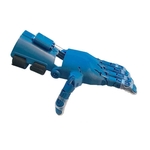Phoenix v2 Hand
---

To learn about what each of the above icons represents, please refer to the [Device Ratings Guide](wiki:/s/e-nable-devices/wiki/Device+Ratings+Guide "Device Ratings Guide").
---
.jpg")
**Designers:** Jason Bryant, John Diamond, Scott Darrow, and Andreas Bastian
**Description:**
This is a wrist-powered device. To use this design, the user must have a functional wrist and enough palm to push against the device to force the fingers closed when wrist is bent. For more information, see the [Which Design](wiki:/s/e-nable-devices/wiki/Which+Design%3F#null "Which Design?") page.
This is a remix of the original e-NABLE Phoenix hand by Jason Bryant with replacement components by John Diamond, Scott Darrow and Andreas Bastian. The changes from the original are as follows:
* **Gauntlet** – Original fully 3D printed version replaced with a thermoformed equivalent (lighter, stronger, uses less filament, quicker to print and can be adjusted to better fit the forearm)
* **Gripper box components** – Whippletree doesn’t require tying to the swivel pin using string. The printing support from the swivel pin should be cut/snipped/filed off before assembly. The thumb tensioner pin is shorter so it doesn’t need to protrude from the front of the gripper box.
* **Thermoformable palm mesh** – An easier to assemble alternative to using Velcro in the palm. Can be thermoformed and adjusted to fit the recipient. Two alternative versions, thin/thick, are provided.
* **Palm with supports** – The support structure uses less filament than the original and can be easily, safely and cleanly removed by hand usually without tools.
* **Demo bar** – Used instead of the palm mesh if the hand is to be used for demonstration purposes. It allows a person with a full set of fingers and thumb to wear the hand and operate it.
* **Wrist pin** – This pin has been shortened to allow it to be used with the thermoformed gauntlet.
---
# Files and Resources
**STL Files:** [Link](https://www.thingiverse.com/thing:1453190)
**Source CAD Files:** Not available
**Instructions:** [Link](https://cdn.thingiverse.com/assets/dd/6b/45/30/fc/Phoenix_v2_assembly_guide.pdf)
**Assembly Materials Kit:** [Link](https://shop3duniverse.com/collections/3d-printable-kits/products/phoenix-hand-by-e-nable-assembly-materials-kit)
**Video Tutorials:** [Video 1](https://youtu.be/Der_DD2_zps), [Video 2](https://youtu.be/BihhKHjguZY), [Video 3](https://youtu.be/dW5B_CeJtd8)
**e-NABLE Device Color Customizer:** [Link](https://bymu.eu/customizer/?device=enable-phoenix-hand-v2)



Andrew Schultz ·